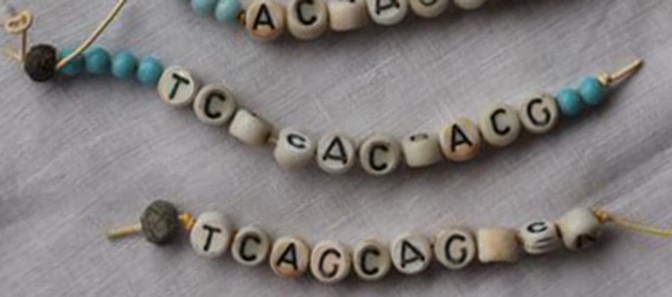It’s in our DNA
If you were to unravel the tightly wound packages of our genome known as chromosomes, you would find long strings of DNA. The strings are made up of only four different building blocks, compounds abbreviated as adenine (A), thymine (T), guanine (G) and cytosine (C). Picture a ridiculously long hospital baby bracelet made only of beads bearing the letters A, T, C, and G.

Our genes are simply stretches along the string of DNA–regions where the order of the compound “beads” is especially important. Genes are the blueprints that code for all the materials needed by our cells. Changes in the order of the building blocks (or, in the case of many spinocerebellar ataxias (SCAs), the addition of too many C-A-Gs), can result in faulty gene products, which can cause disease.
But we can’t all be walking around with identical DNA sequences, like an army of clones! What makes us different? One difference is the small, less consequential changes in the order of the building blocks: variations that usually occur in regions of the DNA between genes, which aren’t critical to gene function.
One such type of variation is called a single nucleotide polymorphism (SNP, pronounced “snip”). Nucleotide is the scientific name for the A, T, C, and G compounds. Polymorphism derives from poly (many) and morph (forms). So a SNP is a change at a single position in the DNA, for example from an A to a C.
Why are SNPs important?
SNPs have been hugely beneficial in helping scientists figure out which genes are linked to disease by acting as biological markers that track with disease genes within families. They may also play a role in therapeutic strategies to lower disease-causing proteins such as the Ataxin proteins that cause some SCAs. SCAsource has previously covered ASO therapy and the clinical trials happening for Huntington’s disease. How can SNPs help with ASO therapies?
ASO therapies are based on the idea of blocking toxic protein production from the inherited disease gene, or “shooting the messenger”. The trouble with this strategy is that everyone actually has two copies of each gene in the genome: one from Mom and one from Dad. Sometimes we don’t necessarily want to block both copies because these genes, when functioning normally, have essential jobs to do in the cell. The ideal situation would then be to block the production of the toxic copy and leave the good copy alone.
For most SCAs, the toxicity comes from the expanded CAG region of the gene. So why not target the extra CAGs? The main problem is that a handful of other genes also have stretches of CAGs. So the drug would have off-target effects. But SNPs lying close to a disease gene are usually inherited along with it. These SNP sites can be targeted by ASO drugs, allowing the drugs to hone in on the toxic copy. The drawback is that these drugs wouldn’t work for people who don’t have the right SNP attached to their disease gene (or who have the same SNP on both copies of the gene).
In summary, just as SNPs tracking with a disease gene helped identify the causes of many genetic diseases, they may also help in their treatment. Vive la difference!
If you would like to learn more about Single Nucleotide Polymorphisms (SNPs), take a look at these resources by the Encyclopedia Brittanica and National Human Genome Research Institute.
Snapshot written by Dr. Tamara Maiuri and edited by Dr. Hayley McLoughlin.










